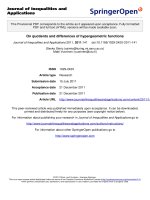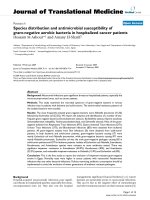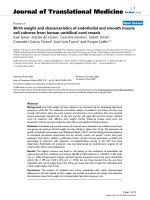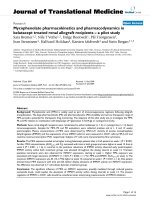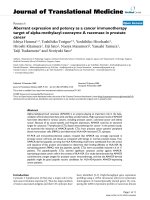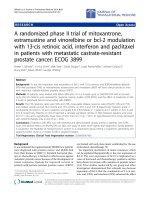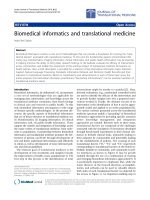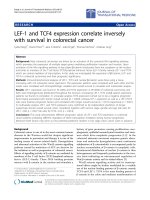báo cáo hóa học: " Factor structure and internal consistency of the 12-item General Health Questionnaire (GHQ-12) and the Subjective Vitality Scale (VS), and the relationship between them: a study from France" potx
Bạn đang xem bản rút gọn của tài liệu. Xem và tải ngay bản đầy đủ của tài liệu tại đây (244.59 KB, 6 trang )
BioMed Central
Page 1 of 6
(page number not for citation purposes)
Health and Quality of Life Outcomes
Open Access
Short report
Factor structure and internal consistency of the 12-item General
Health Questionnaire (GHQ-12) and the Subjective Vitality Scale
(VS), and the relationship between them: a study from France
Mareï Salama-Younes
1
, Ali Montazeri*
2
, Amany Ismaïl
3
and Charles Roncin
3
Address:
1
Laboratory of Social Psychology, Department of Psychology, Rennes II University, Rennes, France,
2
Iranian Institute for Health Sciences
Research, ACECR, Tehran, Iran and
3
Laboratory of Sociology and Anthropology, Departement of Sociology, Rennes II University, France
Email: Mareï Salama-Younes - ; Ali Montazeri* - ; Amany Ismaïl - ;
Charles Roncin -
* Corresponding author
Abstract
Background: The objectives of this study were to test the factor structure and internal
consistency of the 12-item General Health Questionnaire (GHQ-12) and the Subjective Vitality
Scale (VS) in elderly French people, and to test the relationship between these two questionnaires.
Methods: Using a standard 'forward-backward' translation procedure, the English language
versions of the two instruments (i.e. the 12-item General Health Questionnaire and the Subjective
Vitality Scale) were translated into French. A sample of adults aged 58–72 years then completed
both questionnaires. Internal consistency was assessed by Cronbach's alpha coefficient. The factor
structures of the two instruments were extracted by confirmatory factor analysis (CFA). Finally,
the relationship between the two instruments was assessed by correlation analysis.
Results: In all, 217 elderly adults participated in the study. The mean age of the respondents was
61.7 (SD = 6.2) years. The mean GHQ-12 score was 17.4 (SD = 8.0), and analysis showed
satisfactory internal consistency (Cronbach's alpha coefficient = 0.78). The mean VS score was 22.4
(SD = 7.4) and its internal consistency was found to be good (Cronbach's alpha coefficient = 0.83).
While CFA showed that the VS was uni-dimensional, analysis for the GHQ-12 demonstrated a
good fit not only to the two-factor model (positive vs. negative items) but also to a three-factor
model. As expected, there was a strong and significant negative correlation between the GHQ-12
and the VS (r = -0.71, P < 0.001).
Conclusion: The results showed that the French versions of the 12-item General Health
Questionnaire (GHQ-12) and the Subjective Vitality Scale (VS) are reliable measures of
psychological distress and vitality. They also confirm a significant negative correlation between
these two instruments, lending support to their convergent validity in an elderly French population.
The findings indicate that both measures have good structural characteristics.
Published: 5 March 2009
Health and Quality of Life Outcomes 2009, 7:22 doi:10.1186/1477-7525-7-22
Received: 15 October 2008
Accepted: 5 March 2009
This article is available from: />© 2009 Salama-Younes et al; licensee BioMed Central Ltd.
This is an Open Access article distributed under the terms of the Creative Commons Attribution License ( />),
which permits unrestricted use, distribution, and reproduction in any medium, provided the original work is properly cited.
Health and Quality of Life Outcomes 2009, 7:22 />Page 2 of 6
(page number not for citation purposes)
Background
The General Health Questionnaire (GHQ)
The General Health Questionnaire (GHQ) was developed
in England as a screening instrument to identify psycho-
logical distress in primary care settings [1]. It was origi-
nally designed as a 60-item instrument but several
shortened versions are currently available, including the
GHQ-30, the GHQ-28, the GHQ-20 and the GHQ-12.
The shortest version of the questionnaire (GHQ-12) has
been extensively validated and used in a number of coun-
tries and in different languages [2-6]. Since this version is
brief, simple and easy to complete, and its application as
a screening tool in research settings is well documented, it
was decided to translate the GHQ-12 from English into
French and to examine its psychometric properties and
factor structure (i.e. one, two or three factors) in a sample
of elderly French adults.
The Subjective Vitality Scale (VS)
The Subjective Vitality Scale (VS) is a seven-item instru-
ment that was developed by Ryan and Fredrick to measure
vitality [7]. It has two versions: an Individual Difference
Level Version, which asks individuals to respond to each
item by indicating the degree to which it is generally true
in their lives; and the State Level Version, which asks indi-
viduals to respond to each item in terms of how they are
feeling at that moment [8]. The Individual Difference
Level Version was found to relate positively to self-actual-
isation and self-esteem and negatively to depression and
anxiety, while the State Level Version relates negatively to
physical pain and positively to the amount of autonomy
support in a particular situation [8,9]. Another version of
the instrument contains six items. This was developed by
Bostic et al. using confirmatory factor analysis; since one
of the original seven items was negatively worded, they
excluded it to yield a model that fitted their data better
[10]. The questionnaire is a brief measure of vitality pre se
and is simple and easy to complete, and its application as
a uni-dimensional instrument in research settings is well
documented [7,10]; so it was decided to translate it into
French and to examine its factor structure and internal
consistency for the same population.
The relationship between the two instruments
Evidence indicates a strong link between vitality and a
variety of health conditions [11]. Thus, as suggested, it
may be hypothesized that the vitality score will be lower
in cases of somatic pain, physical symptoms and ineffec-
tive body functioning [7]. We were therefore interested in
testing this hypothesis and examining whether there is a
relationship between psychological distress and vitality.
The relationship between the GHQ-12 and the VS has not
yet been tested.
Methods
Translation and data collection
The standard "forward-backward" procedure was applied
to translate the questionnaires (the GHQ-12 and the VS)
from English into French. Two bilinguals translated the
original scales into French. Two independent translators
then back-translated the two translated versions into Eng-
lish. The translators were not connected to the study so
comparability and meaning equivalence were ensured.
Using the different versions, the authors created a provi-
sional French version of each scale. An independent pro-
fessional revised these provisional versions. In general,
minor differences were corrected at this stage by agree-
ment between the different translations and the final ver-
sions were made available for this study. Data were then
collected from a sample of elderly French adults who prac-
tised physical activities regularly in a group. They rated
(self-rated) the GHQ-12 and the VS immediately after
completing their physical activities.
In Western culture, physical activity is considered a life
style model. Many people practise their favourite physical
activity, especially after retirement age, in order to be hap-
pier and healthier. Since there are associations in France
that organise physical activity sessions for older people,
we contacted the Rennes association and recruited the
sample for this study. The participants practised jogging,
walking, cycling, rhythmical gym, yoga, dance and
streatching. At the time of the study they were participat-
ing at least three times per week for a total of 3–4 hours.
Measures
1. The General Health Questionnaire (GHQ-12)
This is a widely-used instrument designed to screen for
psychological distress. The scale asks whether the
respondent has experienced a particular symptom or
behaviour recently. Each item is rated on a four-point
scale (less than usual, no more than usual, rather more
than usual, or much more than usual) and it gives a total
score of 12 or 36 on the basis of the scoring method
selected. The most common scoring methods are bimodal
(0-0-1-1) and Likert scoring (0-1-2-3). Since the latter pro-
duces a more acceptable distribution of scores for para-
metric analysis (less skewed and less kurtosis), we used
the Likert scoring style for this study. A higher score indi-
cates a greater degree of psychological distress [1].
2. The Subjective Vitality Scale (VS)
the six-item Subjective Vitality Scale (the Individual Dif-
ference Level Version) was used to measure vitality. The
scale asks the respondents to indicate the degree to which
the six positively-worded statements are true for them in
general in their lives. Each item is rated on a 6-point scale
(1 = not at all true, 2 = not true, 3 = almost not true, 4 =
almost true, 5 = true, 6 = very true). The total score ranges
Health and Quality of Life Outcomes 2009, 7:22 />Page 3 of 6
(page number not for citation purposes)
from 6 to 36 with a higher score indicating a better condi-
tion [8,10].
Statistical analysis
Internal consistency was assessed by calculating Cron-
bach's α coefficient. Values of 0.70 or greater were consid-
ered satisfactory [12]. We performed confirmatory factor
analyses (CFA) to assess the structures of the two instru-
ments. The intention was to ascertain which model fits the
data better. There are different suggestions in the literature
about the number, type and cut-off values for goodness-
of-fit required for CFA [13,14]. A popular recommenda-
tion is to present three or four indices from different areas.
Accordingly, we report several goodness-of-fit indicators:
the Goodness of Fit Index (GFI), Adjusted Goodness of Fit
Index (AGFI), Root Mean Square Error of Approximation
(RMSEA) and Relative chi-square (χ
2
/df). The GFI and
AGFI are chi-square-based calculations independent of
degrees of freedom. The recommended thresholds for
acceptable values are ≥ 0.90. The RMSEA tests the fit of the
model to the covariance matrix. As a guideline, values of
< 0.05 indicate a close fit and values below 0.11 an accept-
able fit. The value of χ
2
alone may be used as an index, but
χ
2
divided by the degrees of freedom (χ
2
/df) reduces its
sensitivity to sample size (cut-off values: < 2 to 5) [13,14].
Finally, the relationship between the two instruments was
tested using the Pearson product moment statistic (Pear-
son's correlation coefficient = r). A significant negative
correlation was expected.
Ethics
The authors informed the subjects about the study objec-
tives, that their participation was voluntary, and they
could withdraw at any time. Both oral and written instruc-
tions were given to ensure that the items were understood
(i.e. that there were no right or wrong answers to the ques-
tions and that the participants should freely and honestly
state what they think), and the subjects were reassured
that their responses were confidential.
Results
Descriptive findings
In all, 217 elderly subjects aged 58–72 years (Mean 61.7,
SD = 6.2) entered the study. Most of them were female
(61%) and most were employed (83%). Using the Likert
scale, the mean score was 17.4 (SD = 8.0) for the GHQ-12
(range from 0 to 36), and 22.4 (SD = 7.4) for the VS (range
from 6 to 36). These findings indicate that at least 50% of
the respondents reported less stress and showed high
vitality.
Factor analysis and internal consistency
1. The General Health Questionnaire (GHQ-12)
(i) The single factor model was used initially but it fitted
the data poorly, as shown by the fit indices (Table 1). CFA
indicated that a 12-item uni-dimensional model did not
fit the data well. We found the following figures: Good-
ness of Fit Index = 0.72, Adjusted Goodness of Fit Index =
0.63, Root Mean Square Error of Approximation (RMSEA)
= 0.2, and χ
2
/df = 8.99.
(ii) The indices were improved with a model that split the
items into positive versus negative. CFA yielded a 10-item
two-factor model (positive vs. negative items) that fitted
the data very well. The figures for the indices were: Good-
ness of Fit Index = 0.93, Adjusted Goodness of Fit Index =
0.90, Root Mean Square Error of Approximation (RMSEA)
= 0.02, and χ
2
/df = 2.11.
(iii) Finally, we tested the three factors identified by Gra-
etz ("anxiety and depression", "social dysfunction" and
"loss of confidence") [15]. Analysis showed that the
model was highly consistent with our data. CFA yielded a
12-item three-factor model that fitted the data very well:
Goodness of Fit Index = 0.93, Adjusted Goodness of Fit
Index = 0.90, Root Mean Square Error of Approximation
(RMSEA) = 0.03, and χ
2
/df = 2.26 (Table 1 and Figure 1).
In summary, the two and three factor models fitted the
data very well, while the one factor model did not.
The internal consistency of the questionnaire was meas-
ured using Cronbach's alpha coefficient. This coefficient
was found to be 0.78 for the uni-dimensional model,
while for the two-factor and three-factor models the alpha
values were found to be: Anxiety/depression, 0.84; Social
dysfunction, 0.76; and Loss of confidence, 0.81.
2. The Subjective Vitality Scale (VS)
The CFA yielded a six-item uni-dimensional model that
fitted the data well. The following indices were found:
Goodness of Fit Index = 0.90, Adjusted Goodness of Fit
Table 1: The results obtained from confirmatory factor analysis
for the GHQ-12 and the VS (n = 217)
Latent model χ
2
df GFI AGFI RMSEA χ
2
/df
GHQ-12
One factor 485.26 54 0.72 0.63 0.2 8.99
Two factor 71.96 34 0.93 0.90 0.02 2.11*
Three factor 115.45 51 0.92 0.90 0.03 2.26*
VS
One factor 99.86 9 0.90 0.89 0.2 11.01
GFI: Goodness of Fit Index, AGFI: Adjusted Goodness of Fit Index,
RMSEA: the Root Mean Square Error of Approximation.
* P < 0.01
Health and Quality of Life Outcomes 2009, 7:22 />Page 4 of 6
(page number not for citation purposes)
Index = 0.89, Root Mean Square Error of Approximation
(RMSEA) = 0.2, and χ
2
/df = 11.01 (Table 1).
The internal consistency of the questionnaire was meas-
ured using Cronbach's alpha coefficient and was found to
be 0.83, well above the threshold for a satisfactory value.
Relationship between the GHQ-12 and the VS
The correlation between the GHQ-12 and the VS scores
was investigated and as expected a significant negative
correlation emerged (r = -0.71, P < 0.01), indicating that
those who were more distressed showed lower levels of
subjective vitality (Table 2).
Discussion
The GHQ is a well-known instrument for measuring
minor psychological distress and has been translated into
a variety of languages [2-6,16,17]. However, it is not a tool
for indicating a specific diagnosis. This paper reports data
from a validation study of the 12-item GHQ in France. In
general, the findings showed satisfactory results and were
comparable with most research findings throughout the
world [18-21]. In addition, we report the first data from
France on the Subjective Vitality Scale (VS), lending sup-
port to its validity for use in French populations. Cron-
bach's alpha in our study was 0.83, very close to the value
found by Bostic et al. [10]; for their two data sets, they
reported Cronbach's alpha values of 0.80 and 0.89.
The results of confirmatory factor analysis of the three-factor model of the GHQ-12Figure 1
The results of confirmatory factor analysis of the three-factor model of the GHQ-12.
GHQ12
Item 2
Item 7
Item 6
Item 5
Item 3
Item 4
Item 1
Item 8
Item 9
Item 10
Item 11
Anxiety &
Depression
Social
Dysfunction
Loss of
Confidance
Item 12
0.06
0.05
0.83
0.82
0.84
0.84
0.51
0.73
0.43
0.74
0.68
0.83
0.85
0.64
Health and Quality of Life Outcomes 2009, 7:22 />Page 5 of 6
(page number not for citation purposes)
Although the GHQ-12 was originally developed as a uni-
tary screening measure for psychological problems, there
have been efforts to determine whether it has a multidi-
mensional structure [22]. The World Health Organization
study of psychological disorders in general health care in
15 different centres indicated that there is substantial fac-
tor variation between centres for the GHQ-12 [23]. How-
ever, our results showed not only that two factors
expressing anxiety/depression and social dysfunction
could be identified, but also that three factors (i.e. anxi-
ety/depression, social dysfunction and loss of confidence)
are evident. The findings from the present study showed
that the French version of the GHQ-12 is a valid measure
of psychological distress, but the questionnaire has a dif-
ferent factor structure from that in the original language.
Since there was a strong correlation between the GHQ-12
and the VS, the finding also lend further support to the
notion that vitality is both experientially important and
meaningful, and contains physical and psychological
determinants [7]. In addition, since the existence of links
between vitality and a number of health conditions rang-
ing from sleep difficulties to somatic illnesses has been
well reviewed [11], use of the VS is recommended in
future studies. However, none of the GHQ-12 subscales
were correlated with the VS score. This implies that in
practice one should avoid correlating vitality with anxiety
and depression, social dysfunction or loss of confidence
alone.
In general, the findings from this study indicated that
there is relatively little mental illness in old people prac-
tising physical activities in France and this is strongly asso-
ciated with their perceived vitality. However, it should be
noted that our participants were a selected sample, so
these findings cannot be generalized to the whole elderly
population of France.
Conclusion
The findings suggest that the French version of the GHQ-
12 is a reliable and valid instrument for measuring minor
psychological distress in old people and has a good factor
structure. In addition, this is the first study to test the reli-
ability and factor structure of the Subjective Vitality Scale
(VS) in France. The results show that it has good psycho-
metric properties in terms of internal consistency and fac-
tor structure. Finally, as expected, the relationship
between the two instruments was significantly negative,
lending support to their convergent validity.
Competing interests
The authors declare that they have no competing interests.
Authors' contributions
MSY was the main investigator and analysed the data and
wrote the first draft. AI and CR contributed to the study
design and the analysis. AM contributed to the analysis
and wrote the final manuscript. All authors read and
approved the final manuscript.
Acknowledgements
We are grateful to all those who participated in the study.
References
1. Goldberg DP, Blackwell B: Psychiatric illness in general practice.
A detailed study using a new method of case identification.
BMJ 1970, 1:439-443.
2. Politi PL, Piccinelli M, Wilkinson G: Reliability, validity and factor
structure of the 12-item General Health Questionnaire
among young males in Italy. Acta Psychiatr Scand 1994,
90:432-437.
3. Daradkeh TK, Ghubash R, El-Rufaie OE: Reliability, validity, and
factor structure of the Arabic version of the 12-item General
Health Questionnaire. Psychol Rep 2001, 89:85-94.
4. Quek KF, Low WY, Razack AH, Loh CS: Reliability and validity of
the General Health Questionnaire (GHQ-12) among urolog-
ical patients: A Malaysian study. Psychiatry Clin Neurosci 2001,
55:509-513.
5. Kilic C, Rezaki M, Rezaki B, Kaplan I, Ozgen G, Sagduyu A, Ozturk
MO: General Health Questionnaire (GHQ-12, GHQ-28): psy-
chometric properties and factor structure of the scales in a
Turkish primary care sample. Soc Psychiatry Psychiatr Epidemiol
1997, 32:327-331.
Table 2: Descriptive statistics and correlations between the GHQ-12 and the VS (n = 217)
Correlations
MeanSD1 2345
1. The VS score 22.4 7.4 1.00
2. GHQ-12, anxiety and depression 7.8 6.7 -0.10 1.00
3. GHQ-12, social dysfunction 3.7 4.50 -0.08 0.08 1.00
4. GH-12, loss of confidence 5.9 2.2 -0.01 0.02 -0.09 1.00
5. Total score of the GHQ-12 17.4 8.0 -0.71* 0.79* 0.49* 0.26* 1.00
* Significant at < 0.01 level.
Publish with BioMed Central and every
scientist can read your work free of charge
"BioMed Central will be the most significant development for
disseminating the results of biomedical research in our lifetime."
Sir Paul Nurse, Cancer Research UK
Your research papers will be:
available free of charge to the entire biomedical community
peer reviewed and published immediately upon acceptance
cited in PubMed and archived on PubMed Central
yours — you keep the copyright
Submit your manuscript here:
/>BioMedcentral
Health and Quality of Life Outcomes 2009, 7:22 />Page 6 of 6
(page number not for citation purposes)
6. Chan DW: The Chinese General Health Questionnaire in a
psychiatric setting. The development of the Chinese scaled
version. Soc Psychiatry Psychiatr Epidemiol 1993, 28:124-129.
7. Ryan RM, Frederick CM: On energy, personality and health:
subjective vitality as a dynamic reflection of well-being. Jour-
nal of Personality 1997, 65:529-565.
8. Social Determination Theory: Subjective Vitality Scales. The
Scales. [ />index.html]. accessed 20 May 2008
9. Nix GA, Ryan RM, Manly JB, Deci EL: Revitalization through self-
regulation: The effects of autonomous and controlled moti-
vation on happiness and vitality. J Expl Soc Psych 1999,
35:266-284.
10. Bostic TJ, Rubio DM, Hood M: A validation of the subjective
vitality scale using structural equation modelling. Social Indica-
tors Research 2000, 52:313-324.
11. Stewart AL, Hays RD, Ware JE: Health perceptions, energy,
fatigue, and health distress measures. In Measuring functioning
and well-being: The medical outcomes study approach Edited by: Stewart
AL, Ware JE. Durham, NC: Duke University Press; 1992:143-172.
12. Nunnally J, Bernstein IH: Psychometric Theory New York: McGraw-Hill;
1994.
13. Marsh HW, Hau K, Wen Z: In search of golden rules: comment
on hypothesis testing approaches to setting cut-off values for
fit indexes and dangers in over generalizing Hu and Bentler's
findings. Structural Equation Modelling 2004, 11:320-341.
14. Byrne BM: Structural Equation Modelling Mahwah, NJ: Lawrence Erl-
baum Associates Publishers; 1998.
15. Graetz B: Multidimensional properties of the General Health
Questionnaire. Soc Psychiatry Psychiatr Epidemiol 1991, 26:132-138.
16. Tait RJ, French DJ, Hulse GK: Validity and psychometric proper-
ties of the General Health Questionnaire-12 in young Aus-
tralian adolescents. Aust N Z J Psychiatry 2003, 37:374-381.
17. Montazeri A, Mahmood Harirchi A, Shariati M, Garmaroudi G, Ebadi
M, Fateh A: The 12-item General Health Questionnaire
(GHQ-12): translation and validation study of the Iranian
version. Health Qual Life Outcomes 2003, 1:66.
18. Campbell A, Knowles S: A confirmatory factor analysis of the
GHQ12 using a large Australian sample. Eur J Psychol Assess
2007, 23:2-8.
19. Martin CR, Newell RJ: Is the 12-item General Health Question-
naire (GHQ-12) confounded by scoring method in individu-
als with facial disfigurement. Psychology and Health 2005,
20:651-659.
20. Mäkikangas A, Feldt T, Kinnunen U, Tolvanen A, Kinnunen ML, Pulk-
kinen L: The factor structure and factorial invariance of the
12-Item General Health Questionnaire (GHQ-12) across
time: evidence from two community-based samples. Psychol
Assess 2006, 18:444-451.
21. Hankins M: The factor structure of the twelve-item General
Health Questionnaire (GHQ-12): the result of negative
phrasing? Clin Pract Epid Mental Health 2008, 4:1-10.
22. Campbell A, Walker J, Farrell G: Confirmatory factor analysis of
the GHQ-12: can I see that again. Aust N Z J Psychiatry 2003,
37:475-483.
23. Werneke U, Goldberg DP, Yalcin I, Ustun BT: The stability of the
factor structure of the General Health Questionnaire. Psychol
Med 2000, 30:823-829.
